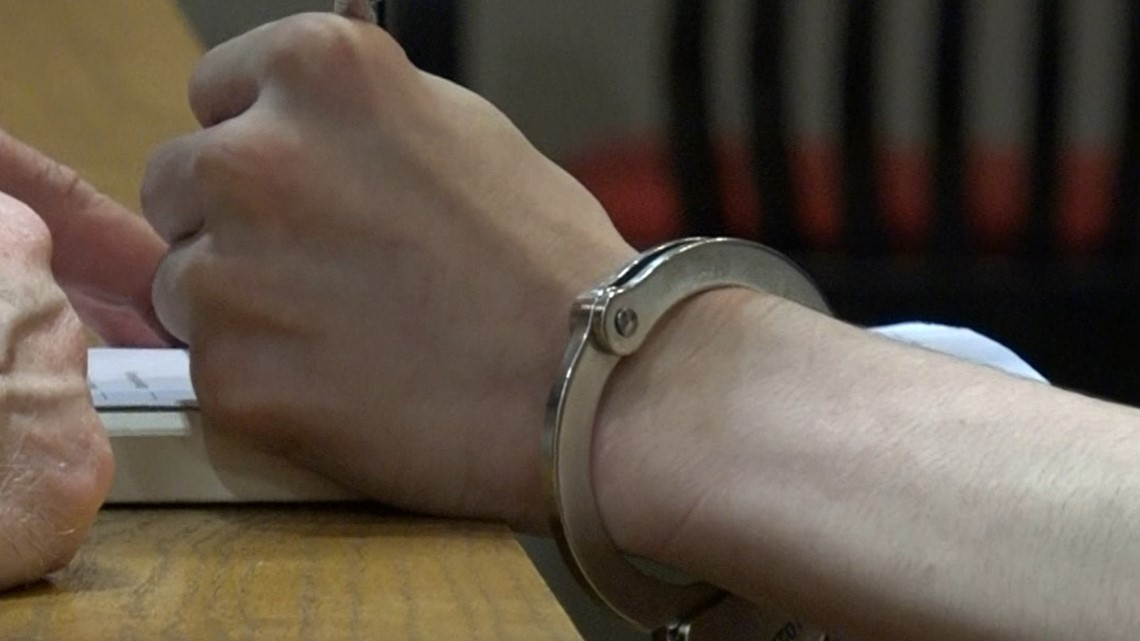
There are double digit or more increases for several categories, including gun-related felonies.
SAN ANTONIO — When the 12-year-old boy stood before the juvenile judge to learn his fate on a felony charge of making a terroristic threat at his school, his tiny fingers were laced behind his back and he was fidgeting.
While trying to make a decision, Judge William Cruz Shaw asked the boy about drug and alcohol use.
“If I test you today, are you going to be dirty?” Shaw said, looking at the boy intently, focused on making a lasting impression.
The boy quietly answered yes. “For what?” Shaw said, forcefully.
“Pot and alcohol,” the almost-teen responded, while his mother chimed in that she had previously supplied the boy with alcohol shots to teach him what it’s like on the streets. The marijuana, the boy said, was given to him by a relative. Shaw said substance abuse is one factor in a recent rise in juvenile crime here in Bexar County.
“We’re having family members who are contributing to the behavior, you know, giving alcohol, giving illegal substances, encouraging them to be out in the streets, late night, early mornings, doing no good. And so, I mean, as a child, who do you listen to? You listen to your family or people around you,” Shaw said.
When asked for one single word to define recent juvenile crime trends, Shaw replied, “Scary. Scary. We’re seeing juvenile crime increase. We don’t know if it’s because SAPD and the Sheriff are making more arrests, but we are seeing a lot more juveniles in our courts on violent offenses. Gun offenses, aggravated offenses, and it’s higher than what we’ve seen in the past.”
In a recent monthly report shared with the Public Safety Committee of the San Antonio City Council, the numbers involving children aged 10 to 16 are eye-opening. Looking at year-to-date referrals through February, non-violent felony reports increased a whopping 135%.
“The majority of those are going to be unauthorized use of a motor vehicle. They’re stealing a lot of cars. They’re going to be breaking into homes, even vacant homes and causing damage inside the home and then using drugs inside these homes,” Shaw said.
The report notes the year-to-date case load went from 120 to 282.
Shaw noted even non-violent crimes rightfully upset law-abiding citizens.
“They’re invading people’s property and sense of a safety net and these kids are violating that,” Shaw said.
The report states violent felony referrals are up 27.5%, from 80 cases to 102.
Shaw said while the numbers are up, it is not an indication there’s a big wave of troubled kids.
“It could be the same kid coming back multiple times for the same referral,” Shaw said. “Most kids that we see are not repetitive. There’s a small group of individuals committing more of the violent offenses. Like we always tell them, if I know your name, that’s a problem. So I think it’s a very small percentage of young folks doing the violent behavior.”
One recent morning in the 436th District Court, in addition to the 12-year-old with the terror threat case, Shaw presided over his usual docket of destructive behaviors by youngsters not even tall enough to clearly see over the judge’s bench.
Many are shackled by chains around their ankles and they nervously twist at the handcuffs on their wrists.
Sometimes, as they wait their turns, there are quiet sniffles and tears wiped away by ill-fitting scrubs.
Parents in the gallery are nervous too. Their legs bounce in fearful anticipation. They try to entertain younger siblings who fill the rows, bearing silent witness to lives seemingly derailed.
A 14-year-old admitted to allegations of unlawfully carrying a weapon and evading arrest. Prosecutors said the boy had been skipping school, missing an entire semester and had been involved with drugs.
“You’re only 14 man, and you’re walking around with guns! I’m tired of dealing with these guns,” Cruz told the boy.
Next up, a 16-year-old charged with burglary, evading arrest and unlawfully carrying, followed by another boy who was 12 years old when he was accused of telling classmates he was at school with a rifle in his backpack.
The report on trends said even in the midst of a rise in violence, the juvenile system remains focused on saving kids, not pushing youngsters into deeper trouble with draconian punishments.
The report notes children are more amenable to rehabilitation, that accountability and treatment must be balanced and that treatment plans have to be tailored to the individual.
Recognizing his role in representation for kids who may have never seen a person of color in a position of authority, Shaw said most days, he intentionally takes to the bench in casual clothing, avoiding a traditional black robe.
“They’ve never seen somebody in a robe and it’s scary. And so they freeze up,” Shaw said, adding he tries his best to get families engaged in the process. “And they talk to me like, wow, he’s a judge! He looks like me. He speaks like me in the same area that I come from and he’s here.”
Shaw said everyone involved in the system has a common goal: turning lives around.
“I’m the judge and I look down and see these kids like ‘you are a spitting image of me,’ and we could both be on the same track. You may have fallen off further than I did, but I’m gonna do whatever I can to keep you out of the adult system and keep you alive,” Shaw said.
Former prosecutor Jill Mata is the Chief Juvenile Probation Officer for Bexar County. “I’ve always been drawn to juvenile work because it’s hopeful work to me,” Mata said, adding ” The vast majority of the kids that come in here want to do well and they do well. You know, we catch them kind of in a misstep where things aren’t aligned and we can really help get them right back out into their lives where they’re living successfully.”
Mata said while the adult system is more focused on punishment, the juvenile system is forward looking.
“In they juvenile system, the focus is much more on making it better. It’s all about rehabilitation, reconnecting kids to communities, finding pro-social supports and activities that help them succeed,” Mata said.
Mata admits there is a small core group of kids who need much higher levels of care.
“There’s a small group of kids that create the havoc that we’re feeling and hearing about and those kids we need to have much deeper interventions with, and they are a tougher group to help, for sure” Mata said.
Mata said living in a culture of violence begets violence, especially when guns are more available than ever.
“There’s a definite uptick in violent felonies and more violent misdemeanors. We are seeing that and we’re seeing more kids with weapons,” Mata said.
“There’s violent video games and there’s violent media and there’s all kinds of glorification of violence that children are coming into contact with all the time and then you couple that with access to weapons,” Mata said, adding that the brains of youngsters aren’t fully developed yet so they have poor impulse control. “They overreact to events and stimuli so then you have that perfect storm.”
Mata said solutions involve basic common sense, but they require dedicated work.
“When people ask what can we do for kids, some of the things are not that hard,” Mata said. “It takes a commitment. If someone is willing to give an hour a week to a child we really see a big difference if they can commit to that sort of time.”
Mata said they have an active volunteer program and they are constantly recruiting people who want to help provide a support system to a child who just might need a little extra attention.
“Mostly we are looking for grown ups, good-hearted grown ups who want to be a positive mentor for children.”
Investing in these kids doesn’t just help them, Mata said, it lifts up the entire community.
“We cannot solve the problem by merely locking children up because they don’t stay locked up forever. We have to be more creative,” Mata said.
Mata says data proves that long-term lockups are counter-productive.
“Research says that to keep them any longer does more harm than good, so we’re trying to hit that sweet spot where the stay is productive,” Mata said.
“We really have to start the process with the end in mind, where they’re in a mindset to be law-abiding and joyful and hopeful,” Mata added.
Shaw said engagement is key and nobody should wait to see anyone else do the daily work of keeping kids safe.
“We have to mentor. We have to be out there. If we know somebody who’s doing something or going down the wrong path, we have to intervene. We can’t wait to get to probation. Sometimes we have to do it ourselves,” Shaw said.
Shaw said the recent report was prepared for City Council so that elected representatives will have a better understanding of how to support change.
“With our council, people understand that they can come out here and say ‘So what resources do you need? Let me come over there and see what’s going on, what’s happening in my district.’ This provides a better idea of what needs to be done to keep these kids off the street,” Shaw said. “There’s no silver bullet for this problem, or this challenge. But we’re going to continue to fight and hopefully get back on the right track.”
The entire report can be found here.
[embedded content]
Original News Source
Running For Office? Conservative Campaign Management – Election Day Strategies!
